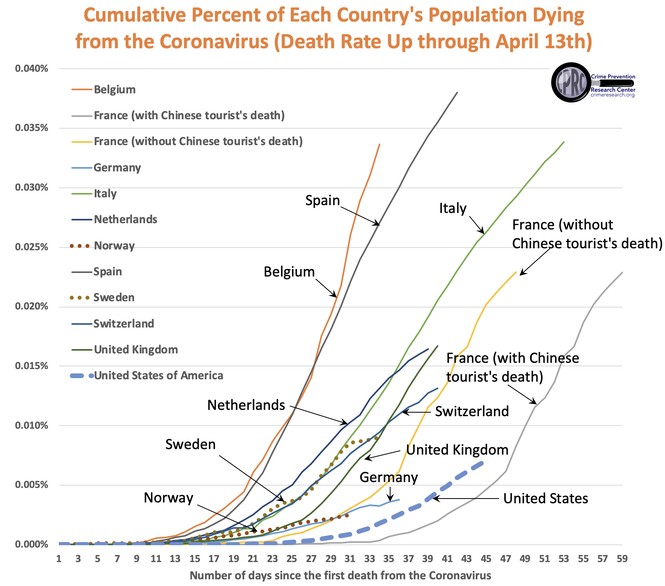Headlines worldwide are announcing that the United States has more coronavirus deaths than any other country. As of early Tuesday morning, Johns Hopkins University reported that the United States had 21,662 deaths. That’s ahead of both Italy (20,465) and Spain (18,056).
Many use the number of deaths as a measure of how the U.S. is faring relative to other countries, but that is extremely misleading. It would be the same comparing the number of rapes in Sweden and the United States. For example, while Sweden had 5,960 rapes in 2014, the United States had 84,767. But does that mean that a woman was more likely to be raped in the United States? Hardly. The United States has about 33 times more people living in it than Sweden. Sweden’s rape rate per capita is more than twice the rate in the United States.
It makes no more sense to compare the number of Wuhan coronavirus deaths in the U.S. versus other countries than it does to compare rape rates. But looking at the death rate also isn’t perfect. The length of time of exposure to the virus also matters, and different countries faced exposure at different times. A country that has had been the chance to expose people over months is going to have a lot more potential deaths than a country where exposure has just taken place over a few days.
Testing varies dramatically across countries, most of which are woefully undercounting cases. But at least in highly developed Western countries, we can be relatively confident that doctors will identify if someone died from the virus.
Recommended
When we adjust for population, it is clear that the U.S. has fared very well at each date after the first death compared to Western Europe. Belgium, Germany, Italy, the Netherlands, Norway, Spain, Sweden, Switzerland, and the United Kingdom all have higher coronavirus death rates than the U.S.
The only country that isn’t clear for is France, and that is because a Chinese tourist who was visiting France died 11 days before anyone else in the country died from the virus. If you include the Chinese tourist in the death count, the 11 days without any additional deaths makes the spread of the virus deaths in France look a little slower than those in the U.S. But if we exclude that one case, the U.S. looks much better in slowing the spread of the disease.

There are several surprises in the data. Sweden, which has not locked down its economy as other European countries and the U.S. have done, is in the middle of the pack in death toll. Sweden is worse than Norway and Finland, but better than the Netherlands and virtually the same as Switzerland.
Germany has gotten a lot of praise for its handling of the virus. Earlier this month, the New York Times ran the headline: “A German Exception? Why the Country’s Coronavirus Death Rate Is Low.” But while Germany has outperformed most of its neighbors, its per capita death toll is still higher than that of the U.S.
While comparing per capita death rates instead of case counts has its advantages, there are countries such as China whose body counts are simply not reliable. The U.S. death toll is also somewhat dubious but for a different reason that likely results in overcounting. If someone is struck by a car and tests positive for the coronavirus before dying in the emergency room, that person will be counted in the virus death toll.
That is obviously an extreme example, but as Coronavirus Response Director Deborah Birx recently noted: “There are other countries that if you had a preexisting condition and let’s say the virus caused you to go to the ICU and then have a heart or kidney problem some countries are recording [this] as a heart issue or a kidney issue and not a COVID-19 death. . . . [In the US] if someone dies with COVID-19 we are counting that as a COVID-19 death.”
Governments’ coronavirus response policies won’t explain all of the differences across countries. Some countries are simply healthier than others. The vast majority of coronavirus deaths are associated with pre-existing conditions, such as obesity, diabetes, high blood pressure, and heart or lung disease. Those rates vary a lot across countries. Americans are more likely to be obese and have diabetes, but are somewhat less likely to have high blood pressure. The quality of the existing medical system also matters a lot, and the U.S. system has few equals.
The media is spending so much time these days is trying to pin blame on someone for the coronavirus deaths. A lot of people have died, it’s true. But we don't have to be so hard on ourselves. For many reasons, the U.S. is faring substantially better than Western European nations.
John R. Lott Jr. is the president of the Crime Prevention Research Center and the author, most recently, of “The War on Guns.”

























Join the conversation as a VIP Member